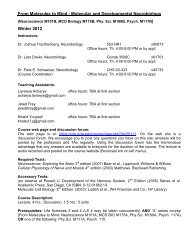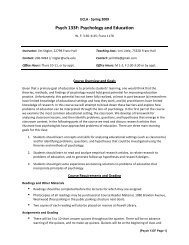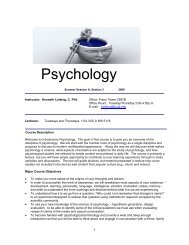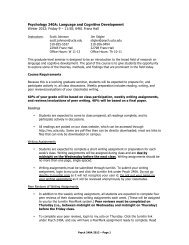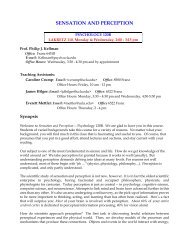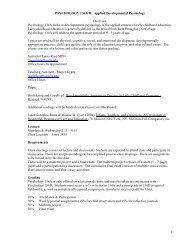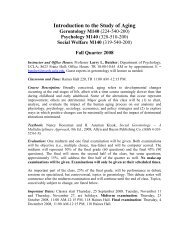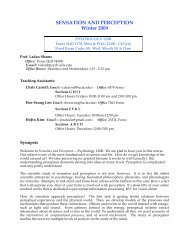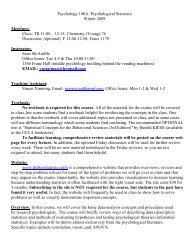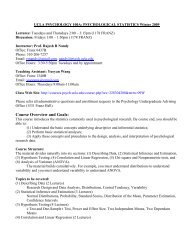Syllabus - Courses in Psychology - UCLA
Syllabus - Courses in Psychology - UCLA
Syllabus - Courses in Psychology - UCLA
Create successful ePaper yourself
Turn your PDF publications into a flip-book with our unique Google optimized e-Paper software.
ADVANCED RESEARCH METHODS IN DEVELOPMENTAL PSYCHOPATHOLOGY<br />
<strong>Psychology</strong> 125c: Spr<strong>in</strong>g, 2011<br />
Professor Bruce L. Baker 3221 Franz Hall 825-9176 baker@psych.ucla.edu<br />
Ms. Shula Green 3178 Franz Hall shulamite@ucla.edu<br />
Ms. Ruth Ell<strong>in</strong>gsen 2214 Franz Hall ruthell<strong>in</strong>gsen@ucla.edu<br />
These two sem<strong>in</strong>ars are coord<strong>in</strong>ated with the Fernald Child Study Center Research Intern<br />
program for undergraduates <strong>in</strong> <strong>Psychology</strong> and are open only to Fernald Interns.<br />
Objectives. The 125b and 125c sem<strong>in</strong>ars will facilitate students' learn<strong>in</strong>g about research<br />
approaches utilized by psychologists to conduct research <strong>in</strong> developmental psychopathology.<br />
Our exploration of research approaches <strong>in</strong> the W<strong>in</strong>ter Quarter considered: hypothesis test<strong>in</strong>g;<br />
controls to reduce threats to validity; measurement; and descriptive, correlational, and<br />
longitud<strong>in</strong>al designs. We considered research approaches with<strong>in</strong> the context of studies <strong>in</strong> child<br />
cl<strong>in</strong>ical psychology that addressed issues such as: measure development, behavioral<br />
observation, cont<strong>in</strong>uity over time, risk and protective factors, self-regulation, high risk<br />
parent<strong>in</strong>g, parent-child <strong>in</strong>teraction, family stress, and well-be<strong>in</strong>g. This quarter we will focus on<br />
<strong>in</strong>tervention research broadly <strong>in</strong> developmental psychopathology. We will consider frequently<br />
used designs (e.g. groups; s<strong>in</strong>gle subjects), program contexts (e.g. evidence-based programs and<br />
program evaluation, <strong>in</strong> university, schools, hospitals, and community agencies) and program<br />
focus (e.g. behavioral parent tra<strong>in</strong><strong>in</strong>g; externaliz<strong>in</strong>g disorders – conduct disorder, ADHD;<br />
<strong>in</strong>ternaliz<strong>in</strong>g disorders – anxiety, depression, eat<strong>in</strong>g disorders; developmental disabilities). We<br />
will cont<strong>in</strong>ue to exam<strong>in</strong>e ethical issues throughout the quarter.<br />
There will be an emphasis on the "case study" approach to learn<strong>in</strong>g; students will learn about<br />
research methods primarily by <strong>in</strong> depth consideration of selected research studies. These<br />
represent a range of issues <strong>in</strong> child psychopathology, cl<strong>in</strong>ical populations, and research<br />
approaches. Exposure to research methods will be through presentations, read<strong>in</strong>gs, class<br />
discussions, writ<strong>in</strong>g, class presentations, and – most importantly -- participation <strong>in</strong> the conduct<br />
of research. The sem<strong>in</strong>ar will be uniquely tailored to fit with other experiences that students<br />
have <strong>in</strong> the Fernald Research Internship program.<br />
Prerequisites: Participation <strong>in</strong> the year-long Fernald Research Intern Program.<br />
Meet<strong>in</strong>gs: All meet<strong>in</strong>gs are at the Fernald Child Study Center. We will meet for 10 hours<br />
weekly, distributed as follows: (a) One and a half hour sem<strong>in</strong>ar TUESDAYS 3:30-5:00; (b) One<br />
and a half hour cod<strong>in</strong>g meet<strong>in</strong>g, other research activity (or sometimes a sem<strong>in</strong>ar) THURSDAYS<br />
3:30-5:00; (c) 7 hours of supervised experience <strong>in</strong> one or more research projects.<br />
Evaluation: Evaluation methods will <strong>in</strong>clude: (a) a term paper (due Friday, June 1), (b)<br />
participation <strong>in</strong> the sem<strong>in</strong>ar, and related written assignments, and (c) participation <strong>in</strong> the<br />
research practicum. There will be no exams.<br />
Weekly Assignments: Students are required to submit brief weekly assignments based on the<br />
read<strong>in</strong>gs. For most weeks they will <strong>in</strong>volve a brief (paragraph or so) article critique; specifics<br />
will be announced <strong>in</strong> class each week. For several weeks they are described <strong>in</strong> the syllabus.
2<br />
SCHEDULE OF CLASSES<br />
SPRING QUARTER: INTERVENTION RESEARCH<br />
1. April 3 Evidence based treatments: Group designs<br />
2. April 10 Ten Commandments of Program Evaluation: Behavioral Parent Tra<strong>in</strong><strong>in</strong>g<br />
3. April 17 Evidence Based Treatments for Child Anxiety/Depression<br />
Adapt<strong>in</strong>g an EBT to a new population<br />
4. April 24 Intervention Research: S<strong>in</strong>gle Subject Designs (Dr. Baker)<br />
5. May 1 Evidence-based treatment for Autism Spectrum Disorders<br />
6. May 8 Evidence-based treatment for children with OCD: Guest speaker Tara Peris<br />
Friday, May 11: Proposals for f<strong>in</strong>al papers due<br />
7. May 15 Evidence-based treatments for ADHD (Dr. Baker)<br />
8. May 22 M<strong>in</strong>dfulness and ACT as evidence-based treatments for ADHD: adapt<strong>in</strong>g EBTs<br />
to a new disorder: Guest speaker Natalie Wieland<br />
Draft of f<strong>in</strong>al papers due for those who want feedback<br />
9. May 29 Translat<strong>in</strong>g evidence-based practices to the community: Guest speaker Mike<br />
Red<strong>in</strong>g<br />
Friday, June 1: F<strong>in</strong>al papers due by 12pm<br />
10. June 5 Student presentations<br />
Background References (Optional; all available at Fernald):<br />
Leary, M. R. (2004). Introduction to behavioral research methods. Boston: Pearson. See<br />
especially chapters 9-13.<br />
Graziano, A. M., & Raul<strong>in</strong>, M. L. (2004). Research methods: A process of <strong>in</strong>quiry. Boston:<br />
Allyn and Bacon. See especially chapters 10-13.<br />
Kazd<strong>in</strong>, A. E., & Weisz, J. R. (2003). Evidence-based psychotherapies for children and<br />
adolescents. New York: The Guilford Press.
3<br />
SPRING QUARTER EXPANDED SCHEDULE OF CLASSES AND READINGS<br />
Read<strong>in</strong>gs designated with (*) are required. Others are optional. Copies of all read<strong>in</strong>gs<br />
(required and optional) are available <strong>in</strong> the CFS office. Please read the papers listed under each<br />
topic before class that week. Read<strong>in</strong>gs are listed <strong>in</strong> the best order to read them.<br />
Week 1. INTERVENTION RESEARCH: ISSUES and GROUP DESIGNS.<br />
*Kazd<strong>in</strong>, A. E., & Weisz, J. R. (2003). Introduction: Context and background of evidence-based<br />
psychotherapies for children and adolescents. In Kazd<strong>in</strong> & Weisz, Ch. 1 pp 3-20.<br />
*Weisz, J. R., Donenberg, G. R., Weiss, B., & Han, S. S. (1995). Bridg<strong>in</strong>g the gap between<br />
laboratory and cl<strong>in</strong>ic <strong>in</strong> child and adolescent psychotherapy. Journal of Consult<strong>in</strong>g and<br />
Cl<strong>in</strong>ical <strong>Psychology</strong>, 63, 688-701. Presents the major problem of differential effectiveness<br />
<strong>in</strong> the laboratory and the real-world.<br />
Hoagwood, K. (2003). Ethical issues <strong>in</strong> child and adolescent psychosocial treatment research.<br />
In A.E. Kazd<strong>in</strong> and J. R. Weisz (Eds.). Evidence-based psychotherapies for children and<br />
adolescents, Ch. 4. New York: Guilford.<br />
Week 2. PARENT TRAINING STUDIES<br />
We will discuss the Cunn<strong>in</strong>gham, Bremner, & Boyle study from the perspective of the<br />
methodological po<strong>in</strong>ts raised <strong>in</strong> the Peterson and Bell-Dolan article. Score Cunn<strong>in</strong>gham et al.<br />
on the Ten (plus) Commandments checklist that will be handed out <strong>in</strong> class.<br />
*Peterson, L., & Bell-Dolan, D. (1995). Treatment outcome research <strong>in</strong> child psychology:<br />
Realistic cop<strong>in</strong>g with the “Ten Commandments of Methodology.” Journal of Cl<strong>in</strong>ical Child<br />
<strong>Psychology</strong>, 24, 149-162<br />
*Cunn<strong>in</strong>gham, C. E., Bremner, R., & Boyle, M. (1995). Large group community-based parent<strong>in</strong>g<br />
programs for families of preschoolers at risk for disruptive behaviour disorders: Utilization,<br />
cost effectiveness, and outcome. Journal of Child <strong>Psychology</strong> and Psychiatry, 36, 1141-<br />
1159.<br />
Baker, B. L. (1997). Parent tra<strong>in</strong><strong>in</strong>g. In J. W. Jacobson & J. A. Mulick (Eds.), Diagnosis and<br />
professional practice <strong>in</strong> mental retardation, 289-299. Wash<strong>in</strong>gton, DC: American<br />
Psychological Association<br />
Week 3. EVIDENCE-BASED TREATMENT FOR CHILD ANXIETY/DEPRESSION<br />
*Walkup, J. T. et al. (2008). Cognitive-behavioral therapy, sertral<strong>in</strong>e, or a comb<strong>in</strong>ation <strong>in</strong><br />
childhood anxiety. New England Journal of Medic<strong>in</strong>e, 359 (26), 2753-2766.<br />
*Wood, J.J. et al. (2009). Cognitive behavioral therapy for anxiety <strong>in</strong> children with autism
4<br />
spectrum disorders: a randomized, controlled trial. Journal of Child <strong>Psychology</strong> and<br />
Psychiatry, 50(3), 224-234.<br />
Week 4. INTERVENTION RESEARCH: SINGLE SUBJECT DESIGNS<br />
We will cont<strong>in</strong>ue our discussion of group designs and then consider s<strong>in</strong>gle subject designs. We<br />
will consider several approaches to s<strong>in</strong>gle-subject research, and then focus on student<br />
presentation of three s<strong>in</strong>gle-subject experiments. The Kazd<strong>in</strong> chapter will be good background.<br />
*Read one of the follow<strong>in</strong>g s<strong>in</strong>gle case articles (as assigned <strong>in</strong> class) and be prepared to report<br />
on it <strong>in</strong> class. Copies will be distributed <strong>in</strong> the first class.<br />
Ayllon, T., Layman, D., & Kandel, H. J. (1975). A behavioral-educational alternative to drug<br />
control of hyperactive children. Journal of Applied Behavior Analysis, 8, 137-146. (A<br />
classic study)<br />
Garf<strong>in</strong>kle, A. N., & Schwartz, I. S. (2002). Peer imitation: Increas<strong>in</strong>g social <strong>in</strong>teractions <strong>in</strong><br />
children with Autism and other developmental disabilities <strong>in</strong> <strong>in</strong>clusive preschool<br />
classrooms. Topics <strong>in</strong> Early Childhood Special Education, 22, 26-38.<br />
Ronen, T., (1991). Intervention package for treat<strong>in</strong>g sleep disorders <strong>in</strong> a four-year-old girl.<br />
Journal of Behavior Therapy and Experimental Psychiatry, 22, 141-148.<br />
Week 5. EVIDENCE BASED TREATMENT FOR AUTISM SPECTRUM DISORDERS<br />
*Rogers, S. J., & Vismara, L. A. (2008). Evidence-based comprehensive treatments for early<br />
autism. Journal of Cl<strong>in</strong>ical Child and Adolescent <strong>Psychology</strong>, 37(1), 8-38. This is an<br />
overview of current research on evidence-based treatments for ASD. (week 7)<br />
* Laugeson, E. A., Frankel, F., Mogil, C., & Dillon, A. R. (2009). Parent-assisted social skills<br />
tra<strong>in</strong><strong>in</strong>g to improve friendships <strong>in</strong> teens with autism spectrum disorders. Journal of Autism<br />
and Developmental Disorders, 39(4), 596-606.<br />
Lovaas, O.I. (1987). Behavioral treatment and normal educational and <strong>in</strong>tellectual function<strong>in</strong>g<br />
<strong>in</strong> young autistic children. Journal of Consult<strong>in</strong>g and Cl<strong>in</strong>ical <strong>Psychology</strong>, 55, 3-9.<br />
Cohen, H., Amer<strong>in</strong>e-Dickens, M., & Smith, T. (2006). Early <strong>in</strong>tensive behavioral treatment:<br />
Replication of the <strong>UCLA</strong> model <strong>in</strong> a community sett<strong>in</strong>g. Journal of Developmental &<br />
Behavioral Pediatrics, 27, 145-155.<br />
Sallows, G. O., & Graupner, T. D. (2005). Intensive behavioral treatment for children with<br />
autism: Four-year outcome and predictors. American Journal on Mental Retardation, 110,<br />
417-438. This is an extremely careful replication of the orig<strong>in</strong>al Lovaas (1987) conditions,<br />
with the same positive f<strong>in</strong>d<strong>in</strong>gs.
5<br />
Week 6. EVIDENCED-BASED TREATMENT FOR CHILDREN WITH OCD<br />
*Storch, E. A. et al. (2007). Family-based cognitive behavioral therapy for pediatric obsessivecompulsive<br />
disorder: Comparison of <strong>in</strong>tensive and weekly approaches. Journal of the<br />
American Academy of Child and Adolescent Psychiatry, 46(4), 469-478.<br />
Week 7. EVIDENCE BASED TREATMENTS FOR ADHD<br />
*Jensen, P. S., et al. (2001). F<strong>in</strong>d<strong>in</strong>gs from the NIMH Multimodal Treatment Study of ADHD<br />
(MTA): Implications and applications for primary care providers. Developmental and<br />
Behavioral Pediatrics, 22, 60-73.<br />
*Anastopoulos, A. D., & Farley, S. E. (2003). A cognitive-behavioral tra<strong>in</strong><strong>in</strong>g program for<br />
parents of children with Attention-Deficit/Hyperactivity Disorder. In Kazd<strong>in</strong> & Weiss, Ch.<br />
11.<br />
*Pelham, W. E., Lang, A. R., Atkeson, B., Murphy, D. A., Gnagy, E. M., Gre<strong>in</strong>er, A. R., Vodde-<br />
Hamilton, M., & Greenslade, K. E. (1997). Effects of deviant child behavior on parental<br />
distress and alcohol consumption <strong>in</strong> laboratory <strong>in</strong>teractions. Journal of Abnormal Child<br />
<strong>Psychology</strong>, 25(5), 413-424.<br />
Week 8. EVIDENCE BASED TREATMENT FOR ADHD: MINDFULNESS & ACT<br />
*Flook, L., et al., (2010). Effects of m<strong>in</strong>dful awareness practices on executive functions <strong>in</strong><br />
elementary school children. Journal of Applied School <strong>Psychology</strong>, 26(1), 70-95.<br />
*Burke, C. A. (2010). M<strong>in</strong>dfulness-based approaches with children and adolescents: A<br />
prelim<strong>in</strong>ary review of current research <strong>in</strong> an emerg<strong>in</strong>g field. Journal of Child and Family<br />
Studies, 19, 133-144.<br />
Week 9. TRANSLATIONAL RESEARCH<br />
*Chorpita, B. F., & Regan, J. (2009). Dissem<strong>in</strong>ation of effective mental health treatment<br />
procedures: Maximiz<strong>in</strong>g the return on a significant <strong>in</strong>vestment. Behaviour Research and<br />
Therapy, 47(11), 990-993.<br />
*Kazd<strong>in</strong>, E. A., & Blase, S. L. (2011). Reboot<strong>in</strong>g psychotherapy research and practice to reduce<br />
the burden of mental illness. Perspectives on Psychological Science, 6(1), 21-37.<br />
Chorpita, B. F. (2003). The frontier of evidence-based practice. In Kazd<strong>in</strong> & Weiss, Ch. 3.<br />
Week 10 STUDENT PRESENTATIONS<br />
This class will feature presentations by <strong>in</strong>terns on term paper research and/or PURC<br />
presentations.



